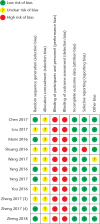Three-dimensional printing in orthopaedic surgery: a scoping review
- PMID: 32818070
- PMCID: PMC7407871
- DOI: 10.1302/2058-5241.5.190024
Three-dimensional printing in orthopaedic surgery: a scoping review
Abstract
Three-dimensional printing (3DP) has become more frequently used in surgical specialties in recent years. These uses include pre-operative planning, patient-specific instrumentation (PSI), and patient-specific implant production.The purpose of this review was to understand the current uses of 3DP in orthopaedic surgery, the geographical and temporal trends of its use, and its impact on peri-operative outcomesOne-hundred and eight studies (N = 2328) were included, published between 2012 and 2018, with over half based in China.The most commonly used material was titanium.Three-dimensional printing was most commonly reported in trauma (N = 41) and oncology (N = 22). Pre-operative planning was the most common use of 3DP (N = 63), followed by final implants (N = 32) and PSI (N = 22).Take-home message: Overall, 3DP is becoming more common in orthopaedic surgery, with wide range of uses, particularly in complex cases. 3DP may also confer some important peri-operative benefits. Cite this article: EFORT Open Rev 2020;5:430-441. DOI: 10.1302/2058-5241.5.190024.
Keywords: 3D printing; additive manufacturing; orthopaedic surgery; patient-specific instrumentation.
© 2020 The author(s).
Conflict of interest statement
ICMJE Conflict of interest statement: SE reports grants from the Research Institute of St. Joseph’s Healthcare Hamilton, PSI Foundation and Michael G. DeGroote Fellowship, not related to the submitted work. DSW is a consultant for Stryker and Intellijoint. The other authors declare no conflict of interest relevant to this work. OA licence text: This article is distributed under the terms of the Creative Commons Attribution-Non Commercial 4.0 International (CC BY-NC 4.0) licence (https://creativecommons.org/licenses/by-nc/4.0/) which permits non-commercial use, reproduction and distribution of the work without further permission provided the original work is attributed.
Figures







References
-
- 3DPI. 3D printing history: the free beginner’s guide. 3D Printing Industry, 2014. https://3dprintingindustry.com/3d-printing-basics-free-beginners-guide/h... (date last accessed 16 January 2019).
-
- Baumers M, Holweg M, Rowley J. The economics of 3D printing: a total cost perspective, 2016. https://www.ifm.eng.cam.ac.uk/uploads/Research/TEG/3DP-RDM_Total_cost_re... (date last accessed 16 January 2019).
-
- Palo M, Holländer J, Suominen J, Yliruusi J, Sandler N. 3D printed drug delivery devices: perspectives and technical challenges. Expert Rev Med Devices 2017;14:685–696. - PubMed
-
- Holländer J, Genina N, Jukarainen H, et al. Three-dimensional printed PCL-based implantable prototypes of medical devices for controlled drug delivery. J Pharm Sci 2016;105:2665–2676. - PubMed
Publication types
LinkOut - more resources
Full Text Sources
Medical

